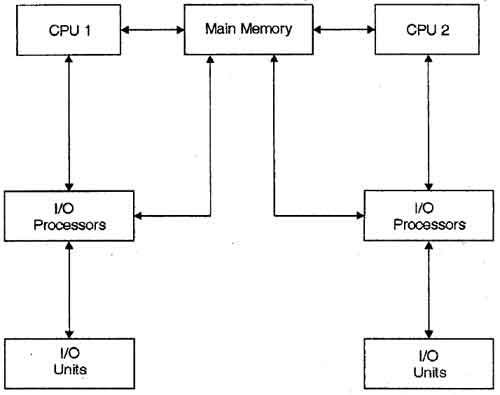Multiprocessor Operating System refers to the use of two or more central processing units (CPU) within a single computer system. These multiple CPUs are in a close communication sharing the computer bus, memory and other peripheral devices. These systems are referred as tightly coupled systems.
These types of systems are used when very high speed is required to process a large volume of data. These systems are generally used in environment like satellite control, weather forecasting etc. The basic organization of multiprocessing system is shown in fig.

Multiprocessing system is based on the symmetric multiprocessing model, in which each processor runs an identical copy of operating system and these copies communicate with each other. In this system processor is assigned a specific task. A master processor controls the system. This scheme defines a master-slave relationship. These systems can save money in compare to single processor systems because the processors can share peripherals, power supplies and other devices. The main advantage of multiprocessor system is to get more work done in a shorter period of time. Moreover, multiprocessor systems prove more reliable in the situations of failure of one processor. In this situation, the system with multiprocessor will not halt the system; it will only slow it down.
In order to employ multiprocessing operating system effectively, the computer system must have the followings:
1. Motherboard Support: A motherboard capable of handling multiple processors. This means additional sockets or slots for the extra chips and a chip-set capable of handling the multiprocessing arrangement.
2. Processor Support: processors those are capable of being used in a multiprocessing system.
The whole task of multiprocessing is managed by the operating system, which allocates different tasks to be performed by the various processors in the system.
Applications designed for the use in multiprocessing are said to be threaded, which means that they are broken into smaller routines that can be run independently. This allows the operating system to let these threads run on more than one processor simultaneously, which is multiprocessing that results in improved performance.
Multiprocessor system supports the processes to run in parallel. Parallel processing is the ability of the CPU to simultaneously process incoming jobs. This becomes most important in computer system, as the CPU divides and conquers the jobs. Generally the parallel processing is used in the fields like artificial intelligence and expert system, image processing, weather forecasting etc.
In a multiprocessor system, the dynamically sharing of resources among the various processors may cause therefore, a potential bottleneck. There are three main sources of contention that can be found in a multiprocessor operating system:
Locking system: In order to provide safe access to the resources shared among multiple processors, they need to be protected by locking scheme. The purpose of a locking is to serialize accesses to the protected resource by multiple processors. Undisciplined use of locking can severely degrade the performance of system. This form of contention can be reduced by using locking scheme, avoiding long critical sections, replacing locks with lock-free algorithms, or, whenever possible, avoiding sharing altogether.
Shared data: The continuous accesses to the shared data items by multiple processors (with one or more of them with data write) are serialized by the cache coherence protocol. Even in a moderate-scale system, serialization delays can have significant impact on the system performance. In addition, bursts of cache coherence traffic saturate the memory bus or the interconnection network, which also slows down the entire system. This form of contention can be eliminated by either avoiding sharing or, when this is not possible, by using replication techniques to reduce the rate of write accesses to the shared data.
False sharing: This form of contention arises when unrelated data items used by different processors are located next to each other in the memory and, therefore, share a single cache line: The effect of false sharing is the same as that of regular sharing bouncing of the cache line among several processors. Fortunately, once it is identified, false sharing can be easily eliminated by setting the memory layout of non-shared data.
Apart from eliminating bottlenecks in the system, a multiprocessor operating system developer should provide support for efficiently running user applications on the multiprocessor. Some of the aspects of such support include mechanisms for task placement and migration across processors, physical memory placement insuring most of the memory pages used by an application is located in the local memory, and scalable multiprocessor synchronization primitives.
 Dinesh Thakur holds an B.C.A, MCDBA, MCSD certifications. Dinesh authors the hugely popular
Dinesh Thakur holds an B.C.A, MCDBA, MCSD certifications. Dinesh authors the hugely popular